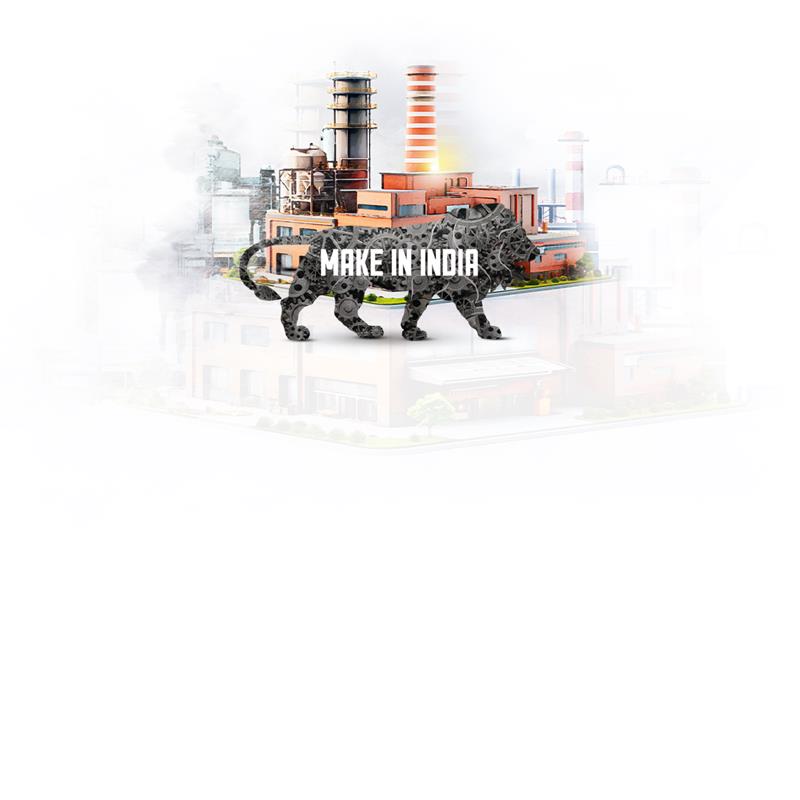- The Make in India initiative has evolved from boosting manufacturing to driving self‑reliance, exports, and sustainability.
- MSMEs play a crucial role in this Make In India initiative by contributing ~30% to India’s GDP, 36–37% of manufacturing output, and 45% of total exports.
- PLI schemes, industrial corridors, and skilling initiatives are enabling them to scale and modernize.
- Moreover, over 110 million people are employed by MSMEs, making them the backbone of India’s industrial workforce.
- Make in India 2.0 urges MSMEs to move beyond a domestic‑only approach, build on quality, and tap into global demand.
When India launched Make in India in September 2014, it was an ambitious vision aimed at elevating manufacturing’s share of GDP to 25% by 2022 (later revised to 2025) and generating 100 million manufacturing jobs. At the time, manufacturing contributed roughly 16.7% of GDP. The ambition was clear: to reduce import dependence, boost domestic output, and attract foreign investment.
From the outset, MSMEs were seen as an integral driver of this vision. Accounting for nearly a third of GDP, over 110 million jobs, and almost half of India’s exports, MSMEs remain the industrial backbone connecting Make in India’s policy ambitions to grassroots economic growth.
Now, a decade later, the government’s renewed push under Make in India 2.0 places even greater emphasis on self‑reliance, global competitiveness, and integrating MSMEs into high‑value global supply chains. This upgraded vision is anchored on three foundational pillars:
- Promoting domestic manufacturing across 25 key sectors, encompassing industries from automobiles to pharmaceuticals and electronic hardware.
- Attracting foreign direct investment (FDI) by encouraging global companies to establish production facilities in India.
- Improving the ease of doing business through comprehensive regulatory reforms and significant infrastructure development.
These foundational elements collectively established the framework for the subsequent evolution of India’s manufacturing sector. Building on these foundations, Make in India 2.0 marks a strategic shift in India’s manufacturing journey. The emphasis has moved beyond capacity expansion to creating an ecosystem that is self‑reliant, innovation‑driven, and globally competitive. This upgraded vision recognizes that manufacturing strength will increasingly depend on quality, resilience, and integration with global value chains rather than scale alone.
Evolution of the Vision: 2014 to 2025
The ‘Make in India’ vision has dynamically evolved since its launch, and the nation’s MSMEs have contributed significantly towards it. The initiative adapted to global economic shifts, technological advancements, and the nation’s strategic priorities, continuously pushing India to move on the path of progress. This evolution can be categorized into three distinct phases.
Phase 1 (2014–2018): Foundations Laid
In the initial years, reforms focused on simplifying rules, streamlining labor laws, and upgrading industrial infrastructure. India jumped 23 places in the World Bank’s ease of doing business rankings by 2017, reaching 63rd position among 190 economies. FDI began rising, and manufacturing growth averaged ~6.9 per cent annually between 2014–15 and 2019–20. Yet, the overall share of manufacturing stayed largely flat or declined between 14–16 per cent of GDP during this stretch.
Phase 2 (2019–2022): From Make in India to Atmanirbhar Bharat
The COVID‑19 pandemic prompted a pivot. The Atmanirbhar Bharat Abhiyan emphasised self‑reliance, local value chains, and support for MSMEs.
A landmark policy intervention during this phase was the introduction of Production-Linked Incentive (PLI) schemes. These schemes, launched in sectors such as electronics and pharmaceuticals, provided financial incentives to encourage domestic manufacturing. Crucially, these programs also benefited MSMEs that serve as suppliers to larger manufacturers. Additionally, initiatives focused on MSME empowerment, including enhanced credit access and digital formalization, gained substantial momentum.
This led to India’s electronics exports growing by over 41%, between FY 2020–21 and FY 2021–22, with MSMEs contributing significantly as component suppliers.
Phase 3 (2023 onwards): Digitalisation, Sustainability and High‑Value Growth
From 2023, the strategy expanded to include green manufacturing, digital systems, and resilience. Export efforts shifted into high‑value segments such as electronics, defence components, and renewable energy. MSMEs began integrating sustainable practices and adopting energy‑efficient technology, aligning with broader environmental and quality standards. As of current estimates for 2025, manufacturing accounts for approximately 13–14% of India’s GDP.
While manufacturing production growth experienced a slowdown, rising just 1.4% in FY 2023-24 compared to 4.7% previously, the initiative continues to demonstrate progress across several key indicators. Despite this slowdown, FDI inflows persisted in manufacturing and MSME-related sectors during this time, indicating sustained global investor confidence. While exact recent figures can vary across sources, ongoing industry and state-level initiatives continue to attract foreign investment.
Today, MSME contributions include:
- Role in Manufacturing Output: According to official data, MSMEs’ Gross Value Added (GVA) share remains around 30% of GDP, while accounting for 36–37% of the total manufacturing output. This highlights their substantial contribution to the country’s industrial production.
- Export Contribution: MSMEs are vital to India’s export performance. They constituted 45.7% of total exports in 2023-24, with this figure increasing to 45.79% by May 2024. This underscores their crucial role in enhancing India’s global trade footprint.
- Employment Generation: The sector is a major source of employment. As per Udyam registrations, MSMEs reported 20.39 crore (over 200 million) in employment by mid-2024. Other sources consistently place total MSME employment over 110 million, solidifying their essential role in livelihoods and national productivity.
Small enterprises demonstrate significant vitality across key manufacturing sectors like auto components, engineering goods, textiles, pharmaceuticals, and electronics assembly.
Policy Support & Industrial Ecosystem for MSMEs
To foster their growth and formalization, several government initiatives, interest subsidy schemes, simplified Udyam registration, and better credit access, have been instrumental in supporting thousands of MSME units:
- PLI Schemes: Production-Linked Incentive (PLI) schemes now strategically target industries with significant MSME supplier bases, including textiles, electronics, and auto components. This encourages larger manufacturers to source domestically, creating substantial opportunities for MSMEs.
- Infrastructure Development: Essential infrastructure projects, such as industrial corridors and cluster development programmes, are designed to group MSMEs, enabling them to achieve economies of scale and share resources. These initiatives are particularly beneficial in Tier 2 and 3 cities by reducing operational costs and fostering collaboration.
- Skill Training Initiatives: To address the need for a skilled workforce, programs like the Skill India Mission and the PM Vishwakarma Scheme are actively building artisan and technical capabilities, ensuring MSMEs have access to trained personnel.
- Enhanced Credit Access: Improving access to finance remains a priority. Platforms like ECLGS (Emergency Credit Line Guarantee Scheme) provided crucial emergency credit during the pandemic. Furthermore, the 2024-25 budget introduced a new credit guarantee fund enabling MSMEs to acquire machinery without collateral, supporting up to ₹1 billion per applicant. Alongside these measures, the government has consistently encouraged NBFCs and other financial institutions to expand business loan offerings to MSMEs, thereby diversifying credit channels and ensuring wider, faster access to funds.
Road Ahead for MSMEs under Make in India
As ‘Make in India’ advances to Make in India 2.0, MSMEs are presented with significant opportunities while also needing to navigate specific challenges.
- Integration into Global Supply Chains: A key priority for the future is to integrate local clusters of component producers into global supply chains. This requires MSMEs to meet stringent international quality standards and scale their operations to serve international manufacturers.
- Lean Manufacturing Adoption: Adopting lean manufacturing practices is emerging as a key driver for MSMEs to enhance efficiency, reduce waste, and remain globally competitive. By streamlining production processes, optimizing resource use, and minimizing defects, MSMEs can significantly lower operational costs while improving product quality. Under the Lean Manufacturing Competitiveness Scheme (LMCS) of the Ministry of MSME, clusters of small units receive handholding support from lean consultants to implement techniques such as 5S, Kaizen, value stream mapping, and just-in-time production. These improvements not only boost profitability but also help MSMEs meet the quality and cost requirements of domestic and export buyers.
- Expansion into Sunrise Sectors: New growth areas offer high potential for MSMEs to diversify and innovate. These include:
- EV component manufacturing – Electric vehicle (EV) component manufacturing is gaining momentum as India pushes toward its 2030 EV adoption targets, supported by state EV policies, FAME-II incentives, and a growing domestic market for battery and charging infrastructure.
- Semiconductors: Semiconductors have become a national priority due to global chip shortages and India’s ambition to develop a self-reliant electronics ecosystem, with the government committing over ₹76,000 crore through the Semiconductor Mission
- Medical devices: Medical devices are in demand as healthcare infrastructure expands post-pandemic, driven by rising domestic consumption, import substitution efforts, and PLI incentives for manufacturing critical equipment locally.
- Drones India is actively seeking deeper local capabilities in all these sectors. MSMEs that can supply firms in these emerging industries stand to gain significantly.
To capitalize on these opportunities, MSMEs will require continued support in areas such as quality upgrades, digital adoption, streamlined finance, and continuous skill training.

